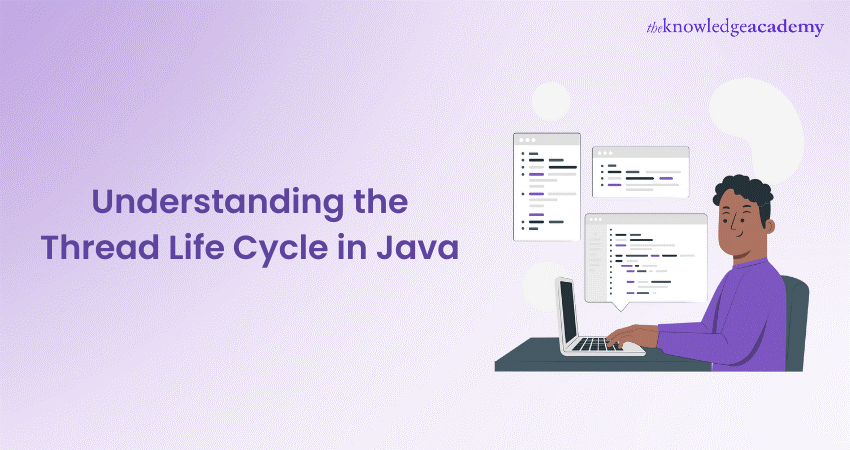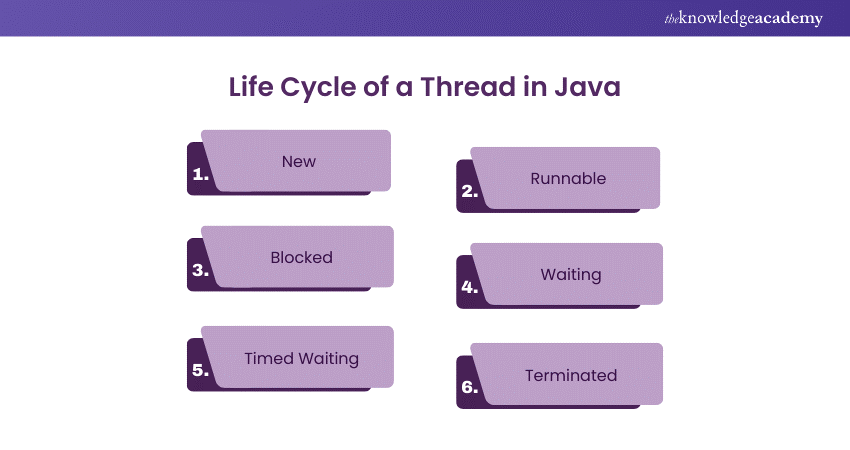We may not have the course you’re looking for. If you enquire or give us a call on +1800812339 and speak to our training experts, we may still be able to help with your training requirements.
Training Outcomes Within Your Budget!
We ensure quality, budget-alignment, and timely delivery by our expert instructors.

In the world of programming, understanding the Thread Life Cycle in Java is essential for building efficient and responsive applications. Java is a powerful language known for its capability to handle multiple tasks simultaneously, thanks to its robust threading model.
However, to harness this power effectively, developers must have a solid grasp of the different states a thread goes through from its creation to its termination. This understanding not only helps in writing more efficient code but also in debugging and optimising applications. This blog will delve into the various stages of Thread Life Cycle in Java, providing insights into each phase and how they interconnect.
Table of Contents
1) What is Thread Life Cycle in Java?
2) Life Cycle of a Thread in Java
a) New
b) Runnable
c) Blocked
d) Waiting
e) Timed Waiting
f) Terminated
3) Conclusion
What is Thread Life Cycle in Java?
The Thread Life Cycle in Java refers to the various stages a thread goes through during its existence, from creation to termination. Understanding this life cycle is crucial for developers who want to effectively manage threads and ensure that their applications run smoothly.
In Java, a thread can be in one of several states, each representing a different phase in its life cycle. These states are managed by the Java Virtual Machine (JVM) and determine how a thread interacts with other threads and resources within the application.
The Thread Life Cycle in Java is well-defined and follows a logical sequence of transitions. Each state has a specific purpose and plays a critical role in the thread's overall operation. By understanding the thread life cycle, developers can write code that optimises thread usage, minimises performance bottlenecks, and avoids common issues such as deadlocks and race conditions.
Life Cycle of a Thread in Java
The life cycle of a thread in Java is a well-defined process, encompassing several states that a thread can occupy during its lifetime. These states include New, Runnable, Blocked, Waiting, Timed Waiting, and Terminated. Each of these states plays a crucial role in the overall functioning of a Java application.

New
The journey of a thread begins in the 'New' state. When a thread is created in Java, it is in this initial state. At this point, the thread has been instantiated but has not yet started executing. This state is represented by the ‘Thread’ object, and the thread remains in this state until the ‘start()’ method is invoked on the ‘Thread’ object.
In this state, the thread is just an object, like any other in Java. It occupies memory but does not consume any CPU cycles as it is not yet running. This state is crucial as it allows the developer to configure the thread before it starts executing, such as setting its priority or naming it.
Runnable
Once the ‘start()’ method is called, the thread transitions to the 'Runnable' state. In this state, the thread is ready to run and is considered alive. However, being in the runnable state does not guarantee that the thread is currently executing. The thread is in the queue, waiting for the thread scheduler to allocate CPU time to it.
The Java thread scheduler is responsible for deciding which thread should run at any given moment. This decision is based on various factors, such as thread priority, the underlying operating system, and the thread scheduling algorithm. When the thread scheduler picks this thread, it transitions from the runnable state to executing its run method.
Blocked
A thread enters the 'Blocked' state when it is waiting for a monitor lock. This typically occurs when the thread tries to enter a synchronised block or method but cannot proceed because another thread already holds the lock for that object. The thread remains in the blocked state until it can acquire the monitor lock, after which it transitions back to the runnable state.
The blocked state is a crucial aspect of Java's synchronisation mechanism, ensuring that shared resources are accessed in a controlled manner, preventing issues such as race conditions and inconsistent data. However, excessive blocking can lead to performance bottlenecks, making it essential for developers to manage synchronised blocks and methods carefully.
Master Java and unlock endless possibilities! Join our Java Programming Course today and start building robust, scalable applications.
Waiting
The 'Waiting' state is another significant phase in the thread life cycle. A thread enters this state when it is waiting indefinitely for another thread to perform a particular action. For example, a thread can enter the waiting state by calling ‘wait()’ on an object, making it wait until another thread calls ‘notify()’ or ‘notifyAll()’ on the same object.
Unlike the blocked state, where a thread is waiting for a monitor lock, in the waiting state, the thread is waiting for a signal from another thread. The thread does not consume any CPU cycles in this state. It will remain in the waiting state until it is notified by another thread or is interrupted. Proper management of threads in the waiting state is crucial to avoid deadlocks, where two or more threads end up waiting indefinitely for each other to release locks.
Timed Waiting
The 'Timed Waiting' state is like the waiting state but with a specified time limit. A thread enters this state when it is waiting for a specific period. Methods like

In this state, the thread remains idle and does not consume CPU resources, like the waiting state. However, the difference is that the thread will automatically transition back to the runnable state after the specified time elapses, even if the event it was waiting for has not occurred. This is particularly useful when you want a thread to wait for a certain amount of time and then proceed regardless of the outcome.
Terminated
The final state in the thread life cycle is the 'Terminated' state. A thread enters this state when its run method has completed execution, either by returning normally or by throwing an uncaught exception. Once a thread is terminated, it is considered dead, and it cannot be restarted.
In this state, the thread has completed its task and releases any resources it was holding. The memory occupied by the thread object is eligible for garbage collection unless there are other references to it. Properly handling thread termination is crucial for ensuring that resources are released appropriately, and that the application does not suffer from memory leaks or other resource-related issues.
Start your coding journey with JavaScript! Turn your ideas into interactive web experiences with our JavaScript for Beginners Training – Register today.
Conclusion
Understanding the Thread Life Cycle in Java is fundamental for any developer working with concurrent programming. Each state—New, Runnable, Blocked, Waiting, Timed Waiting, and Terminated—plays a vital role in how a thread behaves and interacts with other threads and resources. By mastering these states, developers can write more efficient, responsive, and error-free applications.
Ready to become a Java expert? Register for our Java Engineer Training and build the skills to code your future!
Frequently Asked Questions

When a thread dies in Java, it enters the 'Terminated' state, meaning its execution has finished. The thread cannot be restarted, and any resources it held are released, making the thread object eligible for garbage collection if no other references exist.

A waiting thread waits indefinitely for another thread to signal it, while a timed waiting thread waits for a specified period before automatically transitioning back to runnable, regardless of whether it received a signal.

The Knowledge Academy takes global learning to new heights, offering over 30,000 online courses across 490+ locations in 220 countries. This expansive reach ensures accessibility and convenience for learners worldwide.
Alongside our diverse Online Course Catalogue, encompassing 19 major categories, we go the extra mile by providing a plethora of free educational Online Resources like News updates, Blogs, videos, webinars, and interview questions. Tailoring learning experiences further, professionals can maximise value with customisable Course Bundles of TKA.

The Knowledge Academy’s Knowledge Pass, a prepaid voucher, adds another layer of flexibility, allowing course bookings over a 12-month period. Join us on a journey where education knows no bounds.

The Knowledge Academy offers various Java Courses, including Java Programming, JavaScript for beginners, and Java Swing Development Training. These courses cater to different skill levels, providing comprehensive insights into ArrayList in Java.
Our Programming & DevOps blogs covers a range of topics related to Java, offering valuable resources, best practices, and industry insights. Whether you are a beginner or looking to advance your Java Programming skills, The Knowledge Academy's diverse courses and informative blogs have got you covered.
Upcoming Programming & DevOps Resources Batches & Dates
Date
 Java Programming
Java Programming
Mon 6th Jan 2025
Mon 17th Mar 2025
Mon 12th May 2025
Mon 7th Jul 2025
Mon 15th Sep 2025
Mon 3rd Nov 2025
Mon 15th Dec 2025







 Top Rated Course
Top Rated Course



 If you wish to make any changes to your course, please
If you wish to make any changes to your course, please


